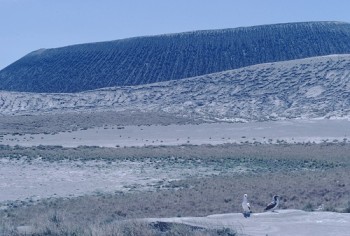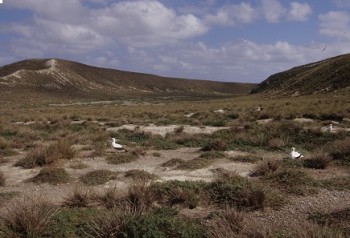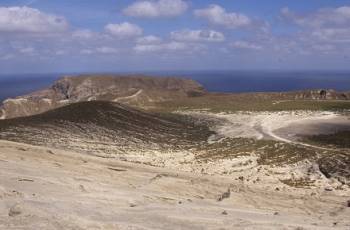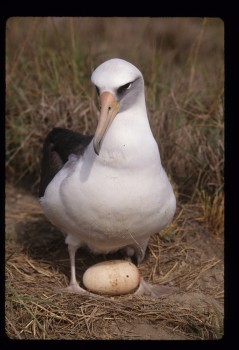Isla San Benedicto is located 370 km south of the tip of Baja California and is one of three main islands in the Mexican Islas Revillagigedos Archipelago. The Reserva de la Biosfera Archipiélago de Revillagigedo (established in 1994) was designated as a Ramsar Wetland Site of International Importance in 2004 and is on Mexico's World Heritage Tentative List, as well as being an Endemic Bird Area.

Bárcena Crater (in the background), which erupted and formed in 1952-53; the photo was taken from Herrera Crater where Masked Boobies breed, March 1988
Isla San Benedicto is a small (6.4 x 3.2 km) uninhabited volcanic island with an elevation of 332 m. In August 1952 the island erupted and destroyed all of the plant life, along with the only two species of breeding landbirds, and most of the breeding seabirds. Over time, the seabirds and some of the vegetation have returned to the island. Currently, the southern half of the island is still largely covered with ash and free of vegetation; the northern half, which supports most of the breeding seabirds, has dense patches of bunch grass Eragrostis diversifolia but little other vegetation.

The north end of San Benedicto Island where most of the seabirds (including albatrosses) breed and nearly all of the vegetation occurs; breeding Masked Boobies are visible, December 1999

From the north rim of Bárcena Crater across Herrera Crater toward the north end of the island showing the sparse dry vegetation, December 1999
The Near Threatened and ACAP-listed Laysan Albatross Phoebastria immutabilis first began scouting for breeding colonies in the eastern Pacific in the mid-1970s, and the first nests were reported (at Guadalupe Island, Mexico) during the 1983/84 winter nesting season. We first observed Laysans roosting on San Benedicto in May 1987, and found the first nest there when we returned in November 1990 – it is likely, therefore, that nesting began sometime in the late 1980s. The colony appears to be growing slowly, from one pair in 1990, two to five pairs in April 1992, eight in December 1999, 12 in December 2000, and 17 in December 2003. Unlike Guadalupe Island, we have not seen any banded birds on San Benedicto.

A Laysan Albatross with a recently laid egg on San Benedicto Island, Mexico, 3 December 1999
The Near Threatened and ACAP-listed Black-footed Albatross P. nigripes was first observed on the island in December 1999 when a single individual was seen roosting with three Laysan Albatrosses. In December 2000 we found a single bird on an egg (although its mate was not present), but in December 2003 we did not find this species on the island, including at the former nest site. Its current status on San Benedicto is unknown.
The Critically Endangered Townsend’s Shearwater Puffinus auricularis has not been reported breeding on the island since the 1952 eruption. However, Wedge-tailed Shearwaters P. pacificus have been recorded breeding with an estimate of 1000 pairs.
Although the seabird populations on San Benedicto are all small-to-moderate in size, it does support perhaps the most diverse population of breeding pelecaniforms of any island in the World, including four species of sulids (Masked, Nazca, Brown and Red-footed Boobies; Sula dactylatra, S. granti, S. leucogaster and S. sula, respectively), two frigatebirds (Great Fregata minor and Magnificent F. magnificens), and probably two species of tropicbirds (Red-billed Phaethon aethereus and Red-tailed P. rubricauta).
It is difficult to get ashore on San Benedicto and currently there are no introduced animals on the island; bird populations there appear to be relatively safe for the time being.
Laysan Albatrosses also breed on Clarion Island in the archipelago (click here).
Photographs by Bob Pitman.
Selected References:
Brattstrom, B.H. 1963. Bárcena Volcano, 1952: its effect on the fauna and flora of San Benedicto Island, Mexico. In: Grissett, J.L. (Ed.). Pacific Basin Biogeography. Honolulu: Bishop Museum Press. pp. 499-524.
Comisión Nacional de Áreas Naturales Protegidas 2004. Programa de Conservación y Manejo Reserva de La Biosfera Archipiélago de Revillagigedo. Tlalpan: Comisión Nacional de Áreas Naturales Protegidas. 220 p.
Howell, S.N.G. & Webb, S. 1990. The seabirds of Las Islas Revillagigedos, Mexico. Wilson Bulletin 102: 140-146.
Pitman, R.L. & Balance, L.T. 2002. The changing status of marine birds breeding at San Benedicto Island, Mexico. Wilson Bulletin 114:11-19.
Pitman, R.L., Walker, W.A., Everett, W.T. & Gallo-Reynoso, J.P. 2004. Population status, foods and foraging of Laysan Albatrosses Phoebastria immutabilis, nesting on Guadalupe Island, Mexico. Marine Ornithology.
Bob Pitman, Southwest Fisheries Science Center, La Jolla, California, USA & John Cooper, ACAP Information Officer, 04 February 2013

 English
English  Français
Français  Español
Español